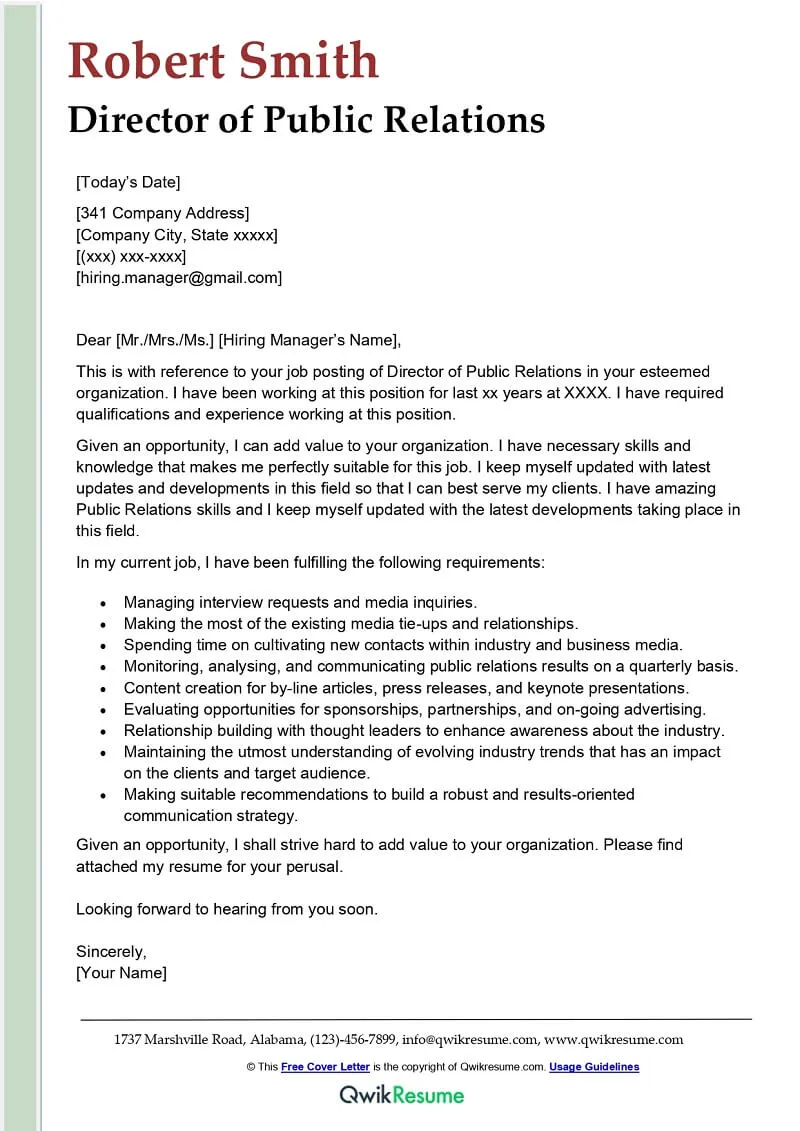What is a PR Cover Letter [Essentials]
A Public Relations (PR) cover letter is a crucial document that accompanies your resume when applying for PR positions. It serves as your first introduction to a potential employer, offering a chance to showcase your skills, experience, and enthusiasm in a more personalized way than your resume allows. A well-crafted cover letter can significantly increase your chances of securing an interview by highlighting your unique qualifications and demonstrating your understanding of the role and the company. It is your opportunity to make a strong first impression, setting the stage for a successful application. Make sure you provide details about your previous experience that matches the job description.
Purpose of a Cover Letter
The primary purpose of a cover letter is to persuade the hiring manager that you are the ideal candidate for the job. It allows you to connect your skills and experience to the specific requirements of the position and the needs of the company. By demonstrating your understanding of the role, your relevant experience, and your enthusiasm for the opportunity, you can set yourself apart from other applicants. A cover letter enables you to explain any gaps in your employment history, address any potential concerns the employer might have, and showcase your personality and communication skills, giving a more human touch to the application. It’s about showing them that you are not just qualified, but also a great fit for the company culture.
Key Elements of a PR Cover Letter
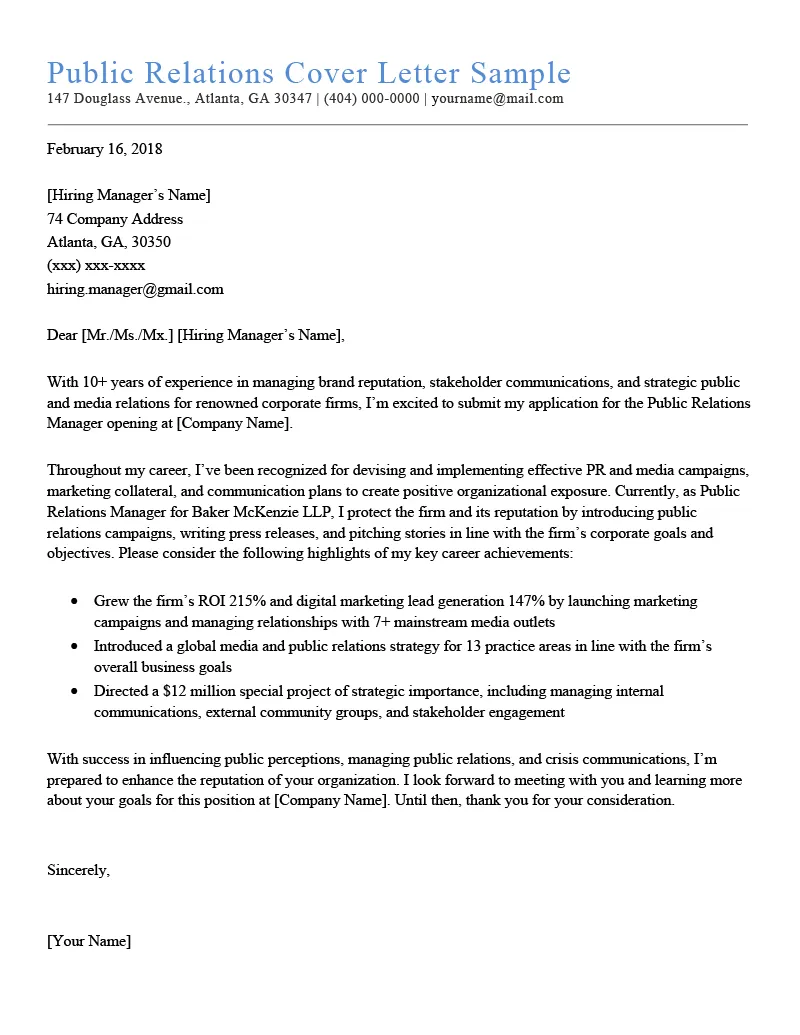
A compelling PR cover letter comprises several key elements that work together to create a persuasive narrative. These elements should be structured logically and professionally. The key elements include your contact information, a professional summary, highlighted relevant skills and experience, quantifiable achievements, and a compelling call to action. Each section of the cover letter must be tailored to the specific job and company you are applying for. It is important to show you are detail oriented and take care of the important things. Review your cover letter before submitting the final version.
Contact Information
Start with your contact information, including your name, phone number, email address, and LinkedIn profile URL (optional). This information should be clearly visible at the top of your cover letter, allowing the hiring manager to easily reach you. Ensure that your email address is professional and reflects well on you. Double-check the phone number and email address for accuracy to avoid any missed communication opportunities. Make sure the information is formatted appropriately and easy to read.
Professional Summary
This is your elevator pitch. In a few sentences, highlight your most relevant skills, experience, and career goals. Tailor this section to match the job description, emphasizing what makes you a good fit for the role. For example, If the job requires strong writing skills, mention your experience in crafting press releases, blog posts, and other content. Be concise and focused on the value you bring to the company. This summary should capture the hiring manager’s attention, prompting them to read further. A well-crafted professional summary immediately conveys your value proposition.
Highlighting Relevant Skills and Experience
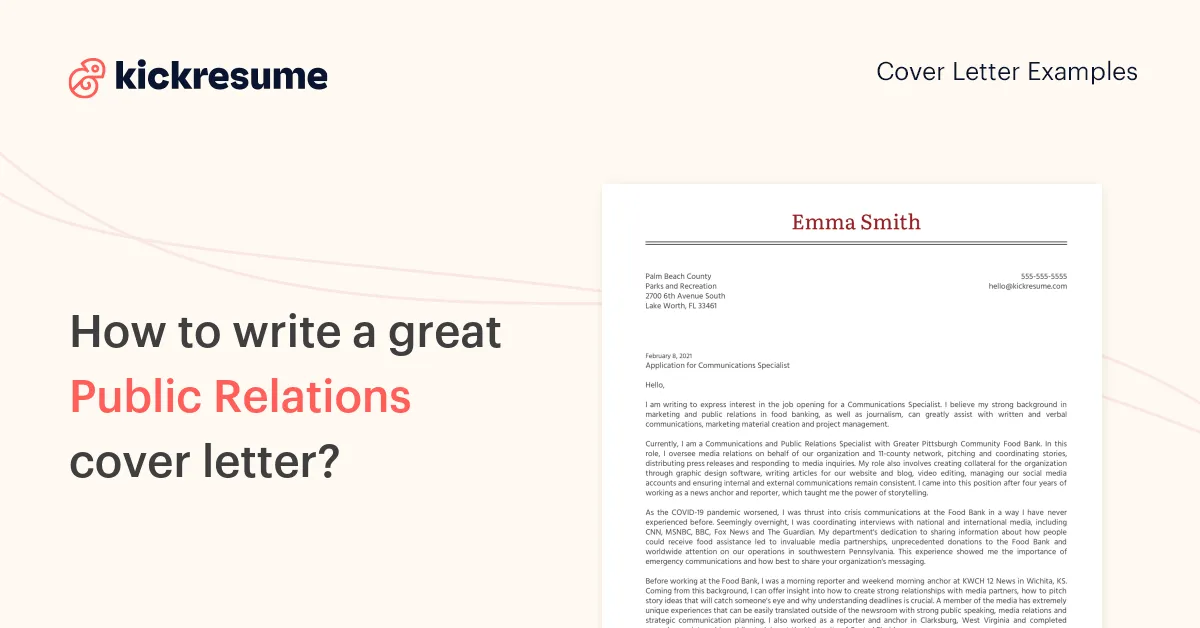
This is where you elaborate on your key skills and experience. Mention specific projects, campaigns, or achievements that demonstrate your abilities. Instead of simply listing your responsibilities, describe your accomplishments and how they align with the job requirements. Use action verbs to describe your work, such as ‘managed,’ ‘developed,’ ‘implemented,’ and ‘achieved.’ Provide concrete examples of how you’ve used your skills to achieve positive outcomes. Show the employer that you understand the requirements and know how to succeed in them. The more you can highlight the experience that matches the job post, the better.
Quantifiable Achievements
Whenever possible, quantify your achievements with data and metrics. Instead of saying you ‘improved social media engagement,’ state that you ‘increased social media engagement by 30% in six months.’ Quantifiable results demonstrate your impact and provide tangible evidence of your skills. Use numbers to showcase your success in previous roles. Examples include the number of media placements secured, the percentage increase in website traffic, or the successful completion of a project. Quantifiable achievements make a stronger impression than general statements and help you stand out from other candidates.
Tailoring Your Cover Letter
Customization is key to writing an effective PR cover letter. A generic cover letter will likely be disregarded. Tailor your letter to each specific job application by researching the company, understanding the job requirements, and adapting your content to match their needs. Show the hiring manager that you have taken the time to understand the role and the company’s values. The more you tailor the letter, the better your chances are. Take your time, be thorough, and provide the necessary information to make the application successful.
Researching the Company and Job

Before writing your cover letter, research the company and the specific job requirements. Visit the company’s website, read their press releases, and explore their social media channels to understand their mission, values, and recent activities. Review the job description carefully, noting the skills, experience, and qualifications the employer is seeking. This research will enable you to tailor your cover letter to demonstrate how your qualifications align with the company’s needs and the job’s demands. Show that you are knowledgeable about the company and excited about the prospect of working there.
Adapting to Different Job Levels
The content and tone of your cover letter should be adapted to the job level. Entry-level cover letters should focus on demonstrating your potential, highlighting relevant coursework, internships, and transferable skills. Mid-level cover letters should emphasize your experience, achievements, and ability to take on more responsibility. Senior-level cover letters should showcase your leadership skills, strategic thinking, and ability to manage teams and projects. Tailor your examples and language to match the expectations of the role.
Entry-Level Cover Letter
For entry-level positions, focus on your education, internships, and any relevant projects or coursework. Highlight your enthusiasm and willingness to learn. Emphasize transferable skills, such as communication, writing, and research. Mention any volunteer work or extracurricular activities that demonstrate your passion for public relations. Show that you have a foundation and are eager to begin your career in the field. Include what you have done in school or during internship to show your strengths.
Mid-Level Cover Letter
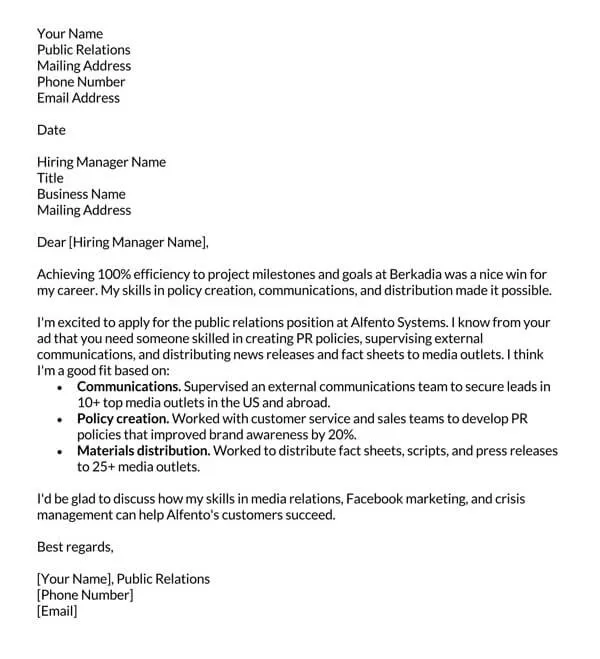
For mid-level positions, showcase your experience, skills, and accomplishments in previous roles. Provide specific examples of successful campaigns you’ve managed, media coverage you’ve secured, and any metrics that demonstrate your impact. Highlight your ability to take on more responsibility and your contributions to team success. Mention any leadership roles or mentorship experience. Focus on the value you bring to the company. This is where you will take a more professional approach.
Senior-Level Cover Letter
For senior-level positions, demonstrate your leadership skills, strategic thinking, and experience in managing teams and projects. Highlight your ability to develop and implement PR strategies, manage budgets, and drive results. Showcase your network of contacts, your experience in crisis communication, and any industry awards or recognition you’ve received. Focus on your ability to contribute to the company’s long-term goals and your value as a strategic leader. Be confident with your experience and skill set.
Cover Letter Formatting and Design
The formatting and design of your cover letter are just as important as its content. A well-formatted cover letter is easy to read and visually appealing. Proper formatting and design ensure that your message is clear and professional. Attention to detail in formatting demonstrates your professionalism and attention to detail, which is crucial in PR. The formatting of your cover letter can reflect the tone of the company you are trying to get hired for. Be sure to follow the guidelines for the best outcome.
Font and Readability
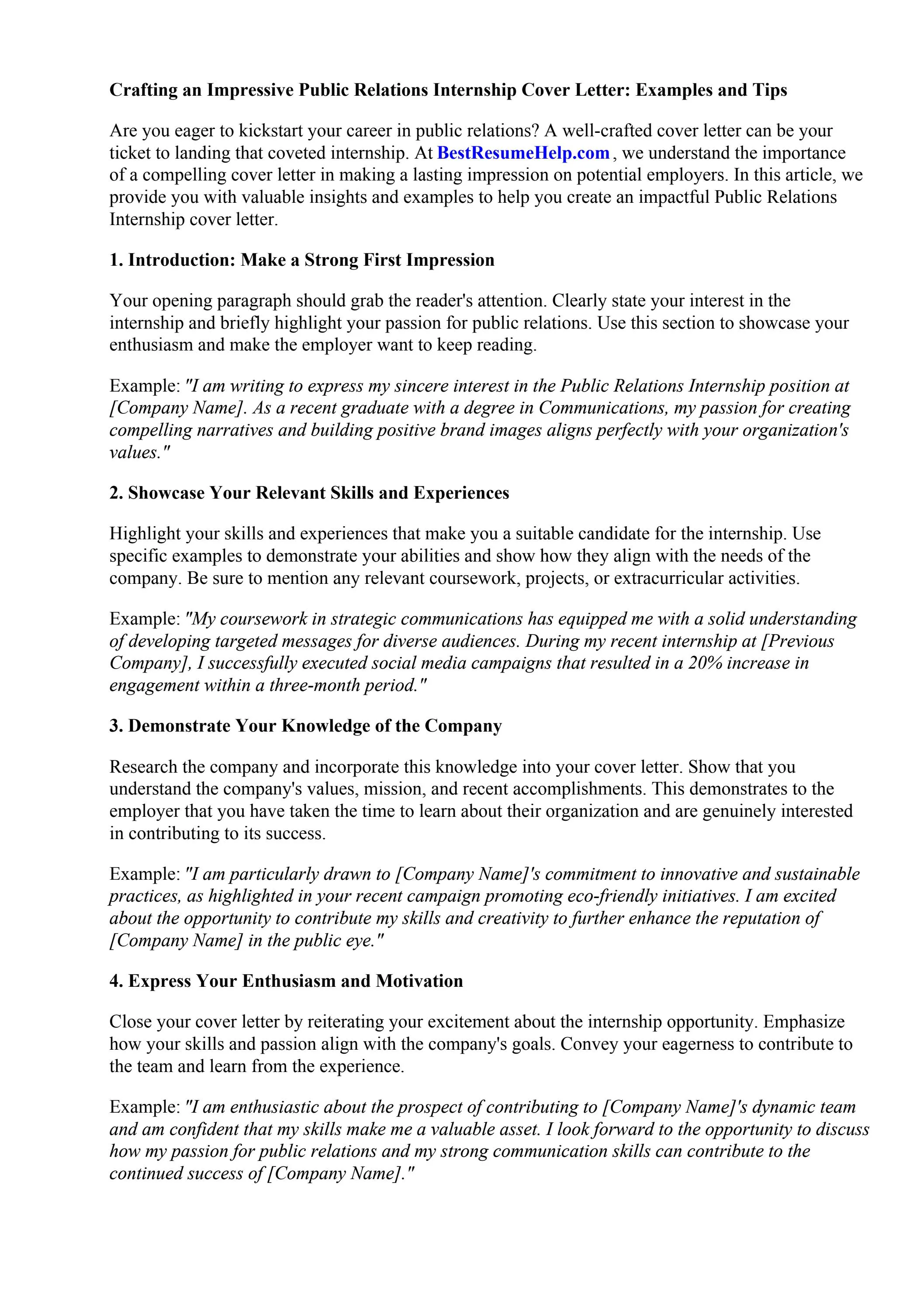
Choose a professional and easy-to-read font, such as Arial, Times New Roman, or Calibri. Use a font size between 11 and 12 points. Ensure that the font size is appropriate. Use a font size that is easy on the eyes. Avoid using overly decorative or unusual fonts that may be difficult to read. Ensure that your cover letter has a clean and uncluttered layout with sufficient white space between paragraphs and sections. This helps the reader navigate the content with ease. Ensure that the formatting looks organized and professional.
Formatting Tips
Use headings, subheadings, and bullet points to break up large blocks of text and improve readability. Keep paragraphs concise and focused. Use a clear and consistent structure, with a logical flow of information. Use bolding to highlight key information and make it stand out. Ensure that the margins are balanced and that the document is properly aligned. Proofread the document to ensure that it is formatted correctly. A properly formatted cover letter demonstrates your professionalism and attention to detail. Always remember to check the format for the best outcome.
Common Mistakes to Avoid
Several common mistakes can undermine your cover letter and reduce your chances of getting an interview. Being aware of these mistakes and avoiding them will significantly improve your application. Avoiding these mistakes will ensure that your cover letter makes the best possible impression. A cover letter can be the first step to your new career. Be sure to take the time to check your cover letter before sending it.
Typos and Grammatical Errors
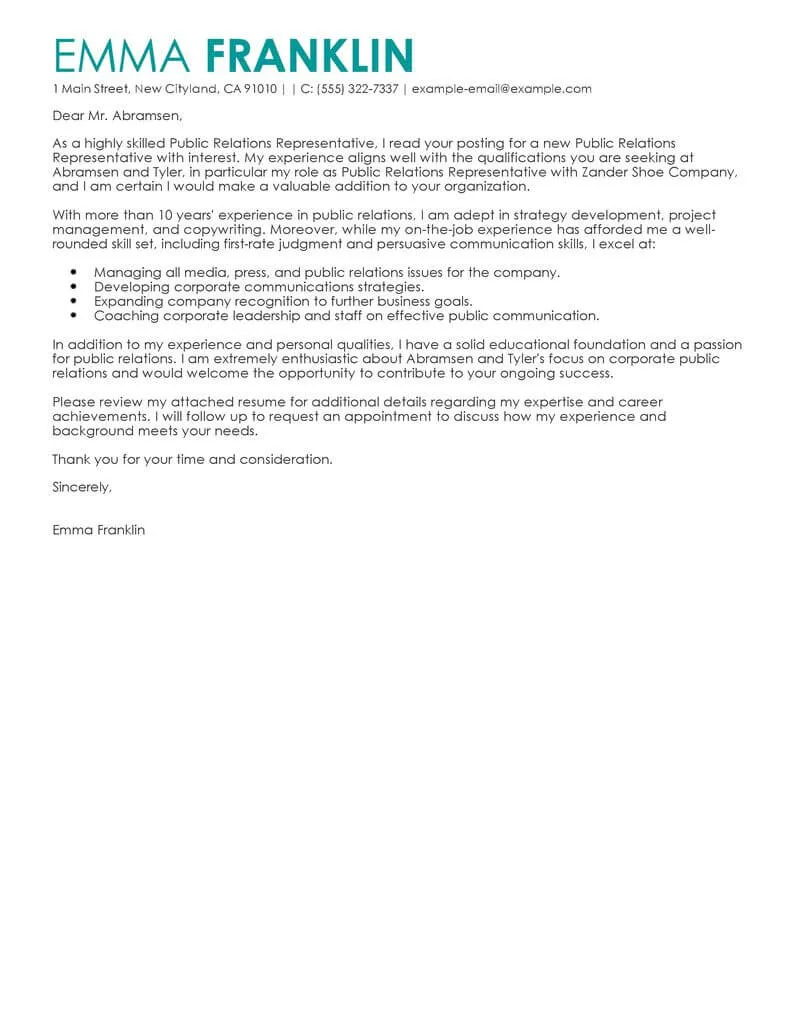
Typos and grammatical errors can create a negative impression and make you seem unprofessional. Always proofread your cover letter carefully, and consider having someone else review it for you. Use grammar and spell-checking tools, but don’t rely on them entirely. A few errors can suggest that you lack attention to detail, which is critical in public relations. Proofread your cover letter multiple times. Proofreading can make a big difference in the outcome of your application. Get a fresh set of eyes to review it as well.
Generic Content
Avoid using a generic, one-size-fits-all cover letter. Tailor each cover letter to the specific job and company. Research the company and job requirements and adapt your content accordingly. Show that you have taken the time to understand the role and are genuinely interested in the opportunity. Generic cover letters demonstrate a lack of interest and effort and make you less likely to be considered. Tailor your letter to the company to show them you care about getting hired.
Overly Formal Tone
While a professional tone is essential, avoid being overly formal or stiff. Inject some of your personality into your cover letter. Write in a clear and concise style. Use a tone that is engaging and reflects your enthusiasm for the role. The best cover letters strike a balance between professionalism and approachability. Make sure the format and wording is clear and concise.
Call to Action and Closing
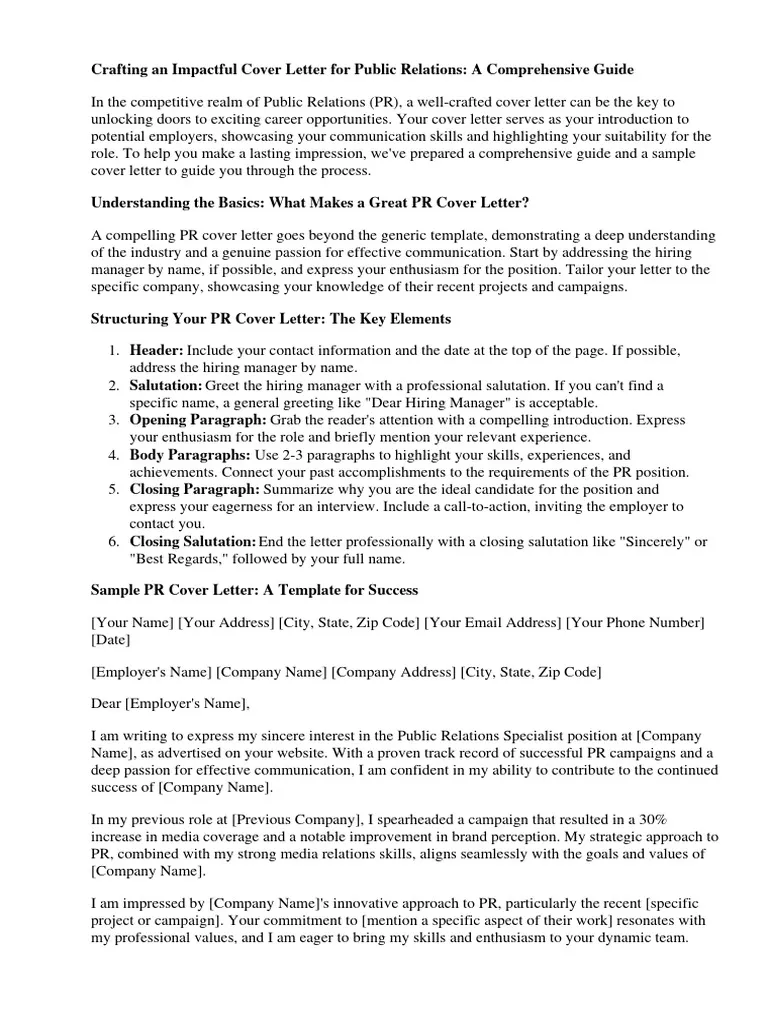
End your cover letter with a strong call to action and a professional closing. Clearly state your interest in the position and your availability for an interview. Express your enthusiasm for the opportunity and reiterate your skills and qualifications. Include a thank you and your contact information. A strong call to action will leave the hiring manager with a clear understanding of your interest and a positive impression of your application. The call to action is just as important as the beginning of the cover letter.
Expressing Enthusiasm
Convey your enthusiasm for the position and the company. Demonstrate your genuine interest in the opportunity and your passion for public relations. Show that you are excited about the prospect of contributing to the company’s success. Use words like ‘eager,’ ‘excited,’ and ‘passionate’ to express your enthusiasm. Enthusiasm can make you stand out from other applicants. Make sure you come across as genuinely excited about getting hired.
Thank You and Contact Information
Thank the hiring manager for their time and consideration. Reiterate your contact information, including your phone number and email address. Make it easy for them to reach you. End with a professional closing, such as ‘Sincerely’ or ‘Best regards,’ followed by your name. A strong closing leaves a positive lasting impression and makes it easy for the employer to contact you. Make sure all your information is available and that you are ready to take a call at any time.
